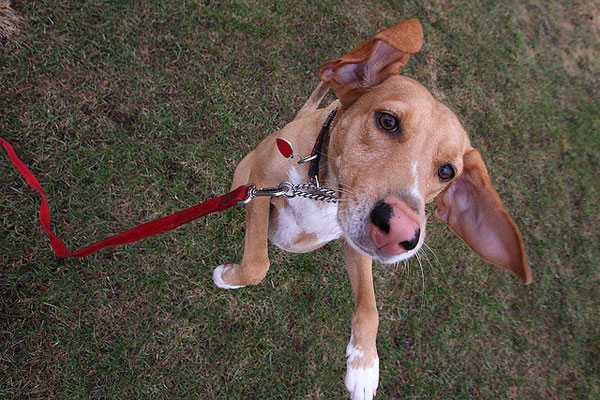Unlike some running partners, dogs won’t sleep in on you or complain about the weather. Photograph by Flickr user TheGiantVermin.
Becoming a runner wasn’t a New Year’s resolution for Shanda Adams—it was a way to get her dog, Riley, out of the house.
After moving to Alexandria in 2008, Adams started coming home to chewed-up baseboards courtesy of her then one-year-old black-Lab/border-collie mix. Riley needed a less destructive way to expend energy. Running, Adams decided, looked like the best option.
“My motto had always been only run if chased,” says Adams, a human-resource specialist at the Treasury Department. “I was not a runner at all.”
But Riley changed her attitude. The pair started slowly. They’d run two blocks, then walk two, adding a little distance each trip. When Adams and Riley joined a dog-friendly running group in early 2009, the three-mile course still seemed too hard. But having Riley by her side pushed her to stick with it: “I look at him and he’s all ready to go with his leash, and even if I don’t want to go, I go.”
When it comes to reaching New Year’s goals to get healthier and fitter, pet owners may have an advantage. Some, like Adams, have seen firsthand the positive impact pets can make. Others might be interested in research that points to the health benefits of interacting with pets, such as lower blood pressure and cholesterol. Studies have shown that people with heart disease have better survival rates if they interact with pets.
Sandra Barker, director of the Center for Human-Animal Interaction at Virginia Commonwealth University, says more research is needed, but studies by her team and others show that pets—and not just dogs—have a physiological effect on people.
“The interaction is mutually beneficial,” Barker says, referring to research indicating that people and animals are less stressed out when they play together and that they experience increased levels of oxytocin, a hormone that creates feelings of love and attachment.
Pet lovers are taking that kind of evidence and running with it. In Burbank, California, trainers at the Thank Dog! Bootcamp combine a cardio and weight workout for humans with obedience training for dogs. Fitness DVDs such as My Best Friend’s Workout demonstrate techniques for intensifying daily dog walks.
Jeff Lutton, a McLean resident who formed the running group that Adams and Riley belong to, was so convinced of the advantages of exercising with his golden retriever, Josie, that when Cardio Canine—a company that makes hands-free running leashes—went up for sale a few years ago, he bought it.
“Josie will stick her nose in my face when the alarm goes off,” Lutton says. “She insists that I get out of bed. And when it’s rainy or cold or windy, she doesn’t complain. She’s different from the typical running partner who might sleep in on you, might not be too excited, might skip it when the weather’s bad.”
On Saturday-morning runs with the Washington Humane Society’s People & Animals Cardio Klub (PACK), dogs from the nonprofit’s shelters get a chance to work out alongside volunteers.
Kevin Simpson, a Humane Society behaviorist who helps run the program, says the animals get just as much out of the exercise as the people: “When they come back from their excursions, they look like how the rest of us feel from doing our run. They seem so much more content. They’re not jittery—they just seem more at peace.”
Adams is more at peace, too, knowing that her morning runs with Riley have curbed the dog’s hyperactivity and anxiety, while her own energy has increased. In 2010, she completed her first Marine Corps Marathon—and she gives Riley all the credit.
This article appears in the January 2012 issue of The Washingtonian.



















